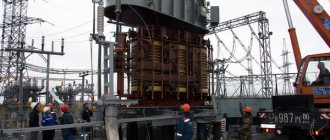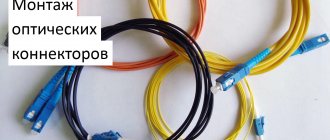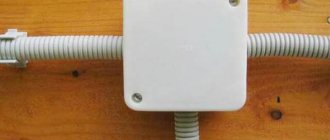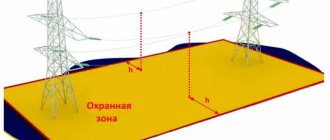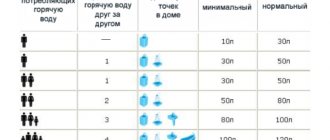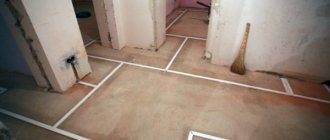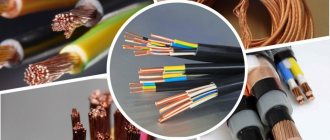Connecting a house, transport facility or engineering structure to the power supply system involves performing a number of electrical installation works. Their list and execution parameters depend on the conditions for implementing the task, but almost always we are talking about a multi-stage project, including a wide range of operations. At the same time, there are standards for the technology of electrical installation work, which prescribe not only the rules for solving certain problems, but also safety requirements, as well as environmental protection.
Electrical Basics
The purpose of electrical installation production is to provide consumers with electricity. Through energy carrier channels, current is delivered to the point of its reception for further use for its intended purpose. At each stage of the movement of electric current from the station of its generation to the direct consumer, certain types of work of this kind can be carried out. For example, in the book “Technology of Electrical Installation Work” by V. M. Nesterenko, a wide coverage of transmission network infrastructure is proposed, taking into account the design of substations and high-voltage networks. In the most popular understanding, electrical installation is still associated with operations that are performed within the infrastructure of an electrical panel - apartment/house. On this circuit, in particular, the most common operations for laying electrical wiring, installing sockets, electrical appliances, protective devices, etc. are performed.
With a wider scope of electrical installation work, it is necessary to consider the measures that are used on the lines of the main networks with transformers, energy conversion and distribution units. As part of the general technology of electrical installation work, operations for connecting networks, installing substations and putting equipment into operation are united by a regulatory framework, however, in each case, the nature of the activities performed has its own nuances in terms of execution rules. Thus, the installation of a main power system unit involves the implementation of construction work with the connection of special equipment and the construction of a foundation for functional units. On the contrary, installation of the simplest lighting device requires only a few minutes and basic skills in handling power tools.
Concepts
Electrician is a general name for several professions associated with the operation and maintenance of electrical and electromechanical equipment. For the common man who is not familiar with the intricacies of the profession, any person associated with electricity will be a simple “electrician”.
The assembly or replacement of electrical panels is carried out by private electricians or employees of the “husband for an hour” service Source Nikastroy.ru
An electrician is a specialist who carries out installation, repair and scheduled maintenance of equipment and power lines.
General technology of electrical installation work
Regardless of the target site at which installation is being carried out and the subject of installation, work is carried out on the basis of a prepared design solution. Even within the framework of minor operations, a conscientious performer uses a diagram, instructions or general regulatory documentation in his work, which allows him to ensure the proper quality of the result. The choice of electrical installation technology is also determined during the creation of the project. The chief engineer, based on the principles of economic feasibility, energy efficiency and safety, determines the most appropriate way to solve the problem with optimal parameters. At this stage, in particular, questions about the method of laying the cable, the equipment used, the number of workers, etc. can be resolved.
The technical part of the work is directly related to installation and, in turn, is divided into two stages. At the first stage, the technology for performing electrical installation work involves installing fasteners and load-bearing devices, which allow, in principle, to solve the problem. For example, in the case of large-format energy systems, this stage will be expressed in the construction of the foundation and installation of the frame for the technical room. When installing the electrical panel, at the same stage the load-bearing elements will be fastened to the wall, and the installation of the socket will require screwing the fixing devices into the prepared niche.
The second stage of installation comes down to the direct installation/placement of a power system element or consuming equipment on a specific section of the supply line, as well as its connection. Again, the nature of the implementation of this stage will depend on the design technology for the work. Electrical installation work in relation to transformer substations, for example, is organized in order to fill the working units of the power system with functional equipment. To optimize installation and connection processes, manufacturers of electrical installation structures have long been developing special modules for integrating electrical devices for the corresponding purpose in a lightweight format. These can be cells and sections for input switches, feeders, distribution devices, elements of the converter unit, relay protection equipment, etc. To ensure convenient connection, electrical collector groups, splitters, blocks and other components can be used, which provide compact devices for fixing and connecting wires.
Video description
Working as an electrician: pros and cons
Most often, an electrician can be seen on the street scurrying back and forth between two electrical poles or hanging on one of them. The main task is to maintain electrical equipment related to the transmission of electrical energy: replacing electrical poles, installing electrical cables, connecting private homes to a section of the main electrical network.
Linear electricians work on an electric pole Source Sochistream.ru
Electrical installation tools and consumables
There are several groups of technical means that are used in the installation of electrical networks and equipment serving them. The specific kits and consumables that will be used in the installation process are, again, determined by the design decision. The universal tools with which electrical installation work is carried out include the following:
- Keys for installing electrical cabinets.
- Round nose pliers and thin nose pliers.
- Pliers.
- Strippers and other devices for removing cable insulation.
- Cable cutters.
- Soldering irons.
- Press jaws.
- Electrical tweezers.
In addition, an electrical fitter works with instruments to measure network performance. This group includes multimeters and testers, as well as specialized instruments such as voltmeters and ammeters.
As for consumables, electrical installation technologies, depending on the conditions of the project, may include the use of the following auxiliary accessories:
- DIN rails.
- Insulating tape.
- Cable channels and boxes.
- Insulating agents.
- Clips and terminals.
- Metal sleeves.
- Distribution devices.
- Brackets and electrical installation masts.
- PVC pipes and profiles to protect wiring.
- Trays and traverses for cable placement.
Installation of electrical substations
One of the first critical nodes on the path of transporting electricity from a current source (nuclear power plant, thermal power plant, hydroelectric power station, etc.) is a complex transformer substation. With its technical arrangement, construction and installation activities are carried out in the following general sequence:
- Preparing the site for work.
- Transportation of building structures and equipment.
- Installation of the substation frame with modules for installing equipment.
- Installation and connection of electrical equipment.
- Commissioning works.
The actual technology for electrical installation work is implemented from the moment the construction of the station buildings is completed and its revision. Next begins the installation of nodes with voltage winding terminals, connection of automatic machines and distribution devices. During installation, contact bars, compression plates with plugs and other electrical fittings are used, through which the transformer infrastructure is formed.
Our prices
| Work area | Price | |
| One-room apartment (up to 35 sq.m; 14 electrical points; boxing up to 8 machines) | from 16,000 rub. up to 35,000 rub. | |
| Two-room apartment (up to 45 sq.m; 16 electrical points; boxing up to 10 machines) | from 22,000 rub. up to 40,000 rub. | |
| Three-room apartment (up to 60 sq.m; 22 electrical points; boxing up to 12 machines) | from 30,000 rub. up to 50,000 rub. | |
| House area up to 70 sq.m (22 electrical points; boxing up to 14 machines) | from 38,000 rub. up to 60,000 rub. | |
| House area up to 110 sq.m (45 electrical points; boxing up to 18 machines) | from 60,000 rub. up to 95,000 rub. | |
| House area up to 150 sq.m (60 electrical points; boxing up to 24 machines) | from 90,000 rub. up to 125,000 rub. | |
View full price list
Technologies for installing overhead power lines
A power transmission line is constructed from the substation to other functional nodes of the energy network for distribution, transformation or direct supply to consumers. The installation item is a self-supporting insulated wire, which is stretched over a certain distance. The phased implementation of the technology for electrical installation work of this type can be presented as follows:
- Fixing the bandage tape on the supporting support. Such tapes are necessary to hold the fastening hooks. They are passed through special holes in the hooks, after which they are pulled and secured with clamps.
- Rolling out the electrical wire. By the time this operation is performed, special rollers must be prepared on the above-mentioned hooks for passing the cable. The wires are led from a special drum from rollers on one pole to another. The ends of the wires are secured with grip stockings and adjusted with traction cables.
- Pulling the wire. According to regulatory requirements, the distance between pillars should not exceed 50 m. This is necessary so that the line does not sag. Modern electrical installation technologies use a combination of a hand winch and a carabiner to achieve optimal tension on a power line. In this case, specific force indicators are monitored using a dynamometer.
Dismantling old wiring in the apartment
Dismantling old electrical wiring is not difficult, but it is important to be careful and follow safety precautions. First of all, you should dwell on the list of tools that you will need for work:
- rubberized gloves;
- pliers;
- screwdriver with voltage indicator;
- insulating tape;
- flashlight.
Before starting work, you need to completely de-energize the power lines in the apartment. To do this, the entrance electrical panel is opened, in which all circuit breakers that power the apartment are turned off.
It is also recommended to understand the principle of disconnecting the shield. In it, the supply cable goes from the riser to the main machine and is always located on top. The lower wires go to apartment groups. Initially, the main circuit breaker is turned off to de-energize the rest of the circuit. But it is also advisable to disable additional machines.
Before you start disconnecting the wires, you should make sure that there is no voltage in them. This is checked with an indicator screwdriver (phase indicator). If there is no voltage, you can proceed to disconnect the wire. Otherwise, you will need to find the reason for the current.
The indicator screwdriver helps to carry out work safely. You should take your time when handling the wires. Before removing the apartment group machine, you should be sure that there is no voltage.
At the end of the manipulations, only one main machine remains in the panel, to which the cable is connected. All circuit breakers and jumpers should be removed, leaving only the wires going into the apartment.
This applies only to phase wires, because neutral wires are connected to the housing itself. After disconnecting the wires, you should check that there is no voltage in all sockets and switches using an indicator screwdriver.
After making sure that there is no voltage, you can begin dismantling the wiring. You need to start with switches, sockets and lamps. You can avoid pulling out old wires by walling them up in the wall and removing or insulating the protruding ends.
If it is necessary to completely remove the old wiring, you will need another tool - a device for detecting hidden wiring lines (thermal imager). It will help you find the route of the wires. After which the power is turned off, the route is opened with a fence cutter and the old wiring is dismantled. New wires are laid into the vacated grooves.
Grounding during electrical installation work
During operation, bare surfaces may form in different sections of power supply lines that are dangerous to people and animals. The complex of protective measures to insure against such situations uses the method of grounding the electrical circuit. Its essence lies in the fact that the part of the power system that is energized is connected to the ground, thereby reducing the ability to resist current in case of accidental contact with other objects. In the same book “Technology of Electrical Installation Work” Nesterenko V.M. proposes to consider grounding devices not just as a conductor for a specific circuit or equipment surface, but as a general integrated solution for connecting the entire local power network to the ground surface. What does it mean? The function of wire elements is performed not only by a random metal object or wire, but by an electrical installation previously calculated in the project, which has a connection to the ground. This solution has two technological features:
- Technically formed by special electrodes that increase the protective function of grounding.
- From the side of connection to the target equipment or network section, it is assumed not a single input, but a group of modules or a block, part of the connecting grooves of which is always free. That is, if it is necessary to ground a new circuit or equipment, it is enough to connect a line from it to the input group. This is usually done via a PE bus, standardized for the needs of protective wiring.
Why you should contact us
Experienced employees of the 3rd and 4th categories with a tolerance of up to 1000 Volts.
All work is carried out in accordance with SNiP 3.05.06-85, PUE ed. 6.7 in compliance with safety measures SNiP 12-03-2001
We conclude an agreement with a precise description of the work and deadlines for delivery of the object
We carry out the work within the deadlines established by the contract.
We use materials from leading manufacturers ABB, Legrand, Schneider Electric.
All consultations are FREE!
Our company has more than 10 years of experience, working with objects of any level of complexity
Our specialist will come to the site completely free of charge
Photos of works
Electrical panel installation and equipment
An electrical panel or cabinet performs the tasks of distributing and receiving electricity to supply end consumers. Initially, a wiring diagram is planned and the optimal location for installing this structure is determined. Depending on the operating conditions of the electrical panel, certain requirements for external protection may be imposed on its housing. For example, household structures have a protection class of IP65, which allows them to operate stably even in conditions of high humidity.
Installation is carried out using brackets and anchors to the wall. That is, holes are prepared in advance for hanging the structure while maintaining the possibility of third-party cable connections. As for the internal contents, modern electrical installation technologies are focused on the individual assembly of the power distribution system of the panel. In special compartments, RCD protective devices and automatic circuit breakers are installed for specific load indicators, which are determined in the design solution. Modular automation, contactors and protection relays are required to be integrated. More modern installations also provide additional functionality with digital measuring devices and indicator lights.
How to assemble an electrical distribution panel
After connecting the wires in the junction boxes, the final step is assembling the electrical panel. There is one characteristic nuance in this process. If the shield is assembled before switching the cables in doses, it will be much easier to check the operation of the electrical network. After all, to supply power to the distribution boxes, you will need to raise or lower the corresponding machine on the switchboard.
To better understand how the elements are arranged, you will need to develop a diagram of the shield.
On it you need to indicate the location of the RCDs and voltage relays. To simplify operation, circuit breakers are divided into groups: “sockets”, “lighters”, “household appliances”, “air conditioners”.
Once the circuit has been developed, you can determine the number and type of electrical products that will be needed to assemble the electrical panel: terminal blocks for phase, neutral and grounding. Based on this, we can conclude that a detailed shield diagram provides many advantages:
- it will be easier for the consumer (apartment owner) to navigate the elements of the panel, especially if the diagram is accompanied by explanatory notes;
- The electrician will be able to save significant time, since he will not have to determine on the fly where to install this or that machine. You just need to carry out the correct installation;
- convenient ordering of the necessary materials for the electrical panel, based on the results of the circuit, which are included in the specification (list of devices). Such a list is used for purchasing electrical equipment and completely eliminates the possibility of shortages or overpayments for unnecessary items.
Placement of wiring, switches and sockets
From the electrical panel to the house or apartment, local wiring circuits for power supply devices are laid. The wiring is placed according to a previously prepared plan diagram in an open or hidden format. In the first case, it may also be necessary to install and assemble cable channels, and in the second, wall grooves are formed to form channels for laying the line at a depth of 2-3 cm. Joints, turns and connections are made using mounting boxes with contactors and a DIN rail.
After the installation of cables is completed, sockets with wiring outlets should remain at the operation site. They install sockets, switches and other electrical infrastructure devices. In this part, the technology of electrical installation work requires the installation of a junction box. It is provided when organizing new electrical wiring. This is a practical solution that will facilitate further work on connecting new electrical devices. The junction box is made of plastic and is mounted in the power cable output unit. Its internal filling contains small-format blocks and distribution rails for connection with distribution wires leading to lighting devices, switches and other points of control and electricity consumption.
Responsibilities and types of work performed by an electrician
Maintenance is a set of works carried out to maintain electrical installations in good condition when using them for their intended purpose, as well as during storage and transportation. It consists of routine maintenance of electrical installations; monitoring their operating modes, monitoring their working condition; carrying out inspections; monitoring compliance with technical operating rules, manufacturer's instructions and local instructions.
Maintenance is an important link in the PPTOR (scheduled preventive maintenance and repair) system, preventing emergency situations; it is carried out by operational and maintenance personnel and is carried out during the operation of electrical installations during breaks, non-working days and shifts.
The operational electrical personnel of enterprises include all workers who service the production electrical installations of a given enterprise in shifts and are allowed to perform operational switching.
Operational services are provided by one person or several persons. The decision on the number of operating personnel in a shift or at an electrical installation is determined by the person responsible for electrical equipment.
Operations personnel work according to the approved schedule.
If necessary, with the permission of the person responsible for the electrical equipment of the enterprise, site, workshop, it is allowed to replace one duty officer with another.
Duty for two shifts in a row is generally prohibited.
The responsibilities of an electrician for servicing electrical equipment in the workshops of industrial enterprises include:
ü preventive inspection of electrical equipment; inspection of protective equipment, fastenings, posts and control buttons;
ü adjustment of starters, relays, devices and other electrical equipment;
ü control over compliance with the rules of technical operation of electrical installations;
ü work on troubleshooting electrical equipment; preventive work to maintain artificial general and local lighting in good condition;
ü checking and troubleshooting the grounding device; preparation of technical documentation for recording the operation of electrical equipment, registration of faults.
During the maintenance of electrical installations, the following work can be performed:
ü detection of faults in electrical circuits;
ü disassembly and assembly of electrical equipment and equipment; threading, drilling, grinding, filing, cutting and chopping of metals, bending and straightening; washing and cleaning of parts;
ü measurements of voltage and current in electrical circuits; replacement of burnt-out fuse links, electric lamps and electric motors.
Work on electrical installations is carried out according to orders, orders, and in the order of routine operation.
Organizational and technical measures that must be carried out when carrying out work in electrical installations are described in detail in the safety regulations, and brief information about them is given below.
Outfit
- this is a written assignment for work in electrical installations, drawn up on a form and defining the place, time of start and end of work, conditions for its safe conduct, composition of the team and persons responsible for work safety. An example outfit is shown below.
Order -
this is an assignment for work in electrical installations, registered in the operational journal by the person who gave the order, or by a person of the operational personnel who receives the order orally directly or via communication means from the person giving the order.
Current operation
- this is the performance of work by operational (operational and repair) personnel in a designated area during one shift.
All works
, carried out in electrical installations
without a work order,
are carried out by order of persons authorized to do so with registration in the operational journal.
The order to carry out work is of a one-time nature, issued for one job and is valid for one shift or 1 hour. If it is necessary to repeat, continue, change the work or the composition of the team, the order must be issued again and recorded in the operational journal.
Enable and disable
individual production mechanisms, units or a group of mechanisms with the help of starting equipment can be produced by persons working on these mechanisms and units, who have undergone appropriate instruction and have the right to independently maintain these units and mechanisms.
Switching in the part of the switchgear served by the power system is carried out only with the permission of the person in charge of the power system and only by persons included in the list agreed with the power system dispatcher.
During single duty at substations and workshop electrical installations, operations in the circuits of electrical devices are carried out by one person, except for the application of grounding.
Switching on and off switches and disconnectors from the control panel in all cases is carried out by one person.
Reactivation of a disconnected oil switch in the case where its drive is not protected by a wall or a metal shield can be done without first checking the disconnected object only remotely.
Simple switching in circuits of electrical installations with voltages above 1000 V and complex switching in switchgears equipped with fully interlocking devices against incorrect operations with disconnectors are carried out without switching forms, but with an entry in the operational log.
In circuits of electrical installations with voltages above 1000 V, when switchgears are not equipped or are not fully equipped with blocking devices against incorrect operations with disconnectors, complex switching is carried out according to switching forms with an entry in the operational log.
When eliminating accidents, switching is carried out without forms with subsequent recording of operations in the operational log.
Technology of electrical installation work on ships
As is the case with the energy supply of buildings, apartments and engineering structures, a project for the installation of electrical equipment and electricity delivery circuits is first developed for the vessel. The main electrical installation measures in this case include the following:
- Along the entire route of laying the power line, the wire is placed, cut, terminated and tested with an insulation check after installation.
- Target electrical equipment is installed at points of direct consumption.
- The main main channels are coiled and tied in the bottomhole areas. We can say that this is backup wiring, which should be reliably protected from damage during periods of inactivity.
- At the final stage, commissioning activities are carried out with measurements of power grid indicators and testing of equipment operation.
Today, parallel technology for performing electrical installation work on ships is increasingly being used, according to which the external and internal organization of the power system is carried out simultaneously. This method is especially effective for block layout of ships. It allows you to optimize installation processes, but it also has its drawbacks. For example, when implementing this method, a strict calculation of energy resources is necessary, since they can be simultaneously used in several functional areas. In addition, there are also organizational problems when installing parallel wiring and connecting equipment in several blocks at once.
Training for electricians, options for obtaining a profession
Designed by pvproductions/Freepik
Primary training of electricians is carried out in training centers of secondary vocational education. As a rule, these are various colleges and technical schools of public utilities. The most common training program is “Electrician for repair and maintenance of electrical equipment (by industry).” Electrician training can be carried out after finishing the 9th grade of secondary school. The terms are about 34 months.
However, electrical systems are different everywhere. So, in order to obtain a narrower specialization, you will have to undergo industrial training directly at the place of work, or even full-fledged professional retraining.



